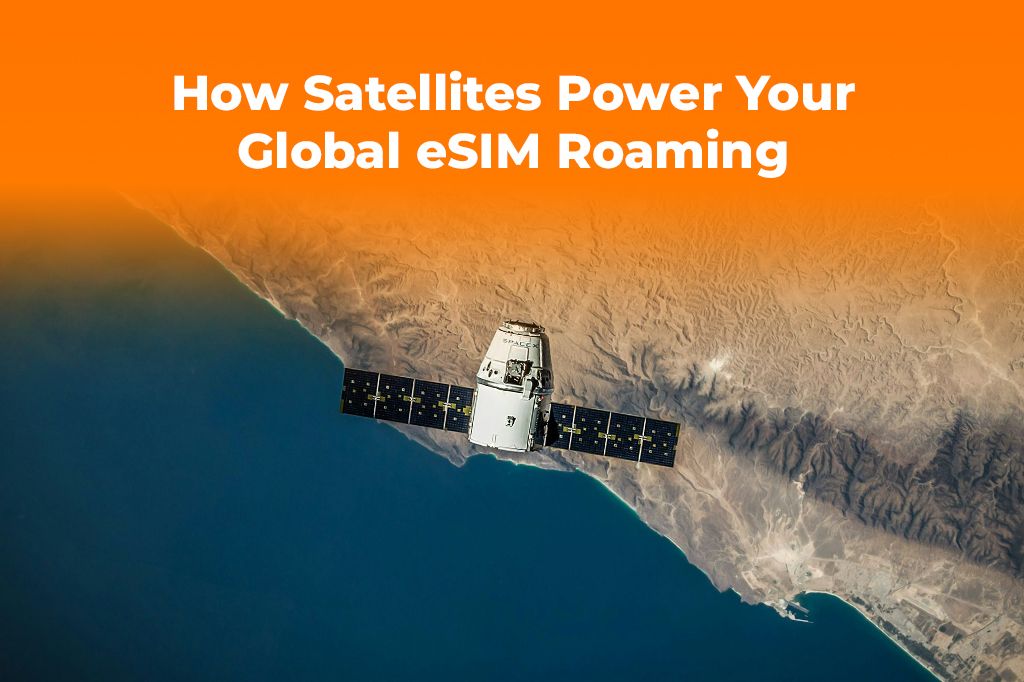The short answer is that your global eSIM roaming connection works because satellites quietly form the backbone of international connectivity, linking mobile networks across borders so you stay online almost anywhere on Earth. This invisible infrastructure supports everything from data routing to global mobile networks and even the future of roaming technology. If you’re preparing for a long trip, you can stay ready by choosing an eSIM plan that works seamlessly across regions.

Understanding How eSIM Technology Connects You Globally
When you first explore what an what is an eSIM card actually does, it might look like magic: no plastic SIM, instant activation, and roaming that works the moment your plane lands. But behind the scenes, this convenience depends on the complex interplay of global mobile networks, satellite communication systems, and roaming technology explained through decades of engineering progress.
Your eSIM connects to different carriers worldwide because mobile operators maintain partnerships across borders. These partnerships ride on an international infrastructure built on land, undersea fiber, and yes, satellites. When you activate your plan, your device authenticates itself using cloud-based systems instead of relying on a physical SIM. This is part of the broader evolution of international connectivity and how modern travelers stay online without swapping tiny pieces of plastic in airports.
Understanding how does eSIM work helps you see why this tech is essential. Instead of binding you to a single carrier, it allows your phone to access multiple networks globally. Many of these connections rely on routing traffic through satellite communication paths when terrestrial fiber isn’t feasible or needs redundancy. Organizations like the GSMA provide standards that make this possible across thousands of operators.
Why Satellites Matter in Global Mobile Connectivity
Even with fast terrestrial networks, satellites remain crucial for keeping global mobile networks interconnected. When you roam internationally, your data might travel across oceans or remote regions where fiber lines don’t reach. This is where satellite communication comes in.
Satellites play three essential roles:
- They connect mobile operators across continents and regions.
- They provide backup routing during outages or congestion on terrestrial networks.
- They support coverage for remote destinations such as deserts, mountains, and mid-ocean flights.
This hybrid infrastructure ensures steady international connectivity for your device. Your global eSIM roaming connection benefits directly because these systems make it possible for roaming partners to manage authentication and route traffic instantly, even when you’re thousands of miles from home.
If you want a smooth travel experience without searching for local SIM kiosks, your best option is to use flexible roaming supported by a strong global backbone. Yoho Mobile offers plans built on these same international connectivity standards so you can stay online from touchdown to takeoff.
The Hidden Journey of Your Data When You Roam Abroad
When you land in another country and your phone connects instantly, it feels simple. But the process underneath is anything but.
-
Local network detection
Your device searches for partner networks that support your eSIM plan. This involves scanning global mobile networks compatible with the roaming agreements embedded in your plan. -
Authentication via satellite-assisted pathways
Even if you’re thousands of kilometers away from your home carrier, your phone still needs to authenticate with their systems. Satellite communication often provides a fast or redundant channel that makes this possible, especially in regions where terrestrial infrastructure is limited. -
Data routing across borders
Once connected, your traffic may hop through multiple networks. Countries with advanced infrastructure rely mostly on fiber, but satellite backup pathways ensure resilience. This is a major reason global eSIM roaming connection technology feels so stable across continents. -
Real-time usage syncing
Your eSIM profile communicates with cloud systems that track your usage, validity, and plan type. These systems depend on international infrastructure designed to handle millions of roaming devices simultaneously.
This entire chain ensures that your eSIM works instantly and reliably. If you’re exploring Asia, Europe, or the Americas, your device is supported by a web of global systems you never see.
How Does eSIM Work Across Satellite-Linked Networks?
To understand roaming technology explained in practical terms, it helps to break it into steps. Here’s how your eSIM interacts with global mobile networks using satellite communication indirectly or directly for support.
-
Remote provisioning systems
Your eSIM profile is downloaded using remote management servers that coordinate with carriers around the world. This process complies with international standards like those described by tech organizations such as the 3GPP, which ensures seamless integration across borders. -
Carrier negotiation
Your device chooses the most stable or highest-priority network. Sometimes your signals traverse both terrestrial and satellite backbones as your connection hops through multiple systems. -
Cross-border traffic verification
Roaming authentication must communicate back to your home provider, often using redundant satellite paths to ensure reliability. -
Service continuity
Once connected, your phone stays registered using protocols designed for uninterrupted international connectivity. If you’re in a remote area, satellite links may take over entirely until you return to urban coverage.
When you’re traveling, relying on a global eSIM roaming connection supported by this infrastructure means you don’t need to pop in a new SIM every time you cross a border. The entire system keeps everything working smoothly in the background.
Travelers often appreciate the simplicity. Wherever you go next, it helps to choose a provider that supports high-quality roaming infrastructure. You can explore how Yoho Mobile works to understand how these systems integrate with user-friendly tools designed for real-world travel.
To make your next international trip stress-free, consider choosing a Yoho Mobile plan that supports wide regional coverage so you don’t have to keep switching networks manually while navigating new destinations.
Real Examples of How Satellite-Backed Roaming Helps Travelers
Here are a few scenarios where satellite-rooted global eSIM roaming connection systems make a difference:
-
Island hopping in Southeast Asia
Many remote islands rely heavily on satellite communication, especially during peak tourist seasons when terrestrial networks overload. Your eSIM stays functional because roaming partners maintain redundant links. -
Business travel across multiple continents
Corporate travelers often cross borders quickly. The authentication process enabled by satellite-connected global mobile networks ensures uninterrupted service. -
Long-distance flights
Some international airlines route onboard Wi-Fi through satellite systems. While this isn’t the same as mobile roaming, it highlights how satellite communication supports mobility worldwide. -
Road trips across remote deserts or rural areas
Some regions have sparse terrestrial towers. Satellite-backed roaming infrastructure ensures that authentication and data routing remain stable.
These examples illustrate why understanding how does eSIM work helps you appreciate the underlying technology. It’s more than mobile data, it’s an entire ecosystem that makes international connectivity possible.
Key Takeaways for Travelers
- Satellite communication quietly supports your global eSIM roaming connection.
- International connectivity relies on hybrid infrastructure that includes undersea cables, land networks, and satellites.
- Understanding roaming technology explained in simple terms helps you choose better travel data options.
- eSIM infrastructure unlocks improved flexibility, cost savings, and global coverage.
- Choosing a reliable provider ensures consistent performance across borders.
When you’re ready for your next international adventure, you can stay connected instantly by browsing Yoho Mobile’s global and regional eSIM options.

FAQs
How does an eSIM work when traveling internationally?
It works by authenticating your device with partner carriers abroad. This system is supported by global mobile networks, cloud-based profile management, and satellite communication used for redundancy.
Do satellites provide my eSIM connection directly?
Not usually. Satellites support the infrastructure behind roaming rather than connecting your smartphone directly, unless you’re using a specialized satellite phone or service.
Why is satellite communication important for roaming?
It ensures coverage continuity, redundancy, and global connectivity, especially when terrestrial infrastructure is unavailable.
Is a global eSIM roaming connection faster than local SIM cards?
Speeds vary by region, but modern eSIM roaming agreements often give you access to the same networks as local users.
Can I use the same eSIM across multiple countries?
Yes. Many international plans support multi-country or regional roaming using the same infrastructure that enables worldwide carrier interoperability.
Conclusion
Satellites play a vital behind-the-scenes role in keeping your global eSIM roaming connection stable and reliable by supporting international connectivity and the complex routing that happens across borders. If you want travel-ready coverage that works wherever you land, explore Yoho Mobile’s flexible international eSIM options.
